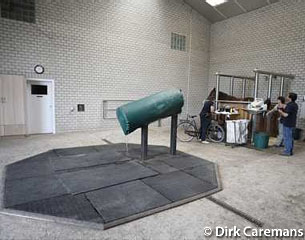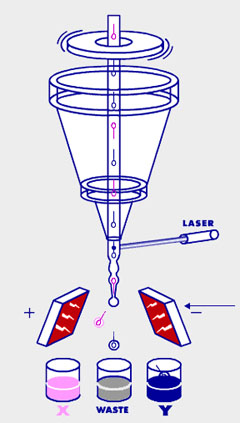
Sexing semen to allow animal owners to choose the desired sex of the offspring is becoming huge in the livestock industry, so why then are horse breeders not employing the same technologies? The answer lies in the ownership rights to the sexing procedure, a limited number of sexing machines, and an over-demand for the technology's use in the cattle and pig industries.
Beginning his research into artificial semen and reproduction in 1985, Dr. Juan C. Samper has spent over 20 years working in the area and headed up the very first commercial ventures into sexed semen.
"The original company to undertake these studies was XY inc., which is now owned by Sexing Technologies from Navasota, Texas. Sexing technologies now owns the rights and intellectual property on sexed semen technologies, and while they began research into horse breeding, they were quickly overwhelmed with the demand from other more profitable industries."
Sexed Semen Not Yet Popular in the Horse Industry
Hired in 2010 to lead the company's research into the equine world, Juan was hired to commercialise sexed semen for horses, around the world, but the company quickly saw they had more profitable opportunities elsewhere.
"I was chosen to lead the research into the horse industry, but after some initial trials in 2010 the company put everything on hold as they were too busy with cattle and pigs," he admitted. "However, my work for the company and indeed the use and commercialisation of sexed semen in the horse industry, will be picked up later this summer."
With the technology still completely unavailable on a commercial basis, the company has only a small number of sexing machines in the world, all of which are owned by the company.
 "There are only a 100 or so machines, which are currently being used exclusively for cattle and pigs, throughout Europe (Italy, Holland, France Germany), and in China, Brazil, The United States, Canada, and New Zealand," Samper explained.
"There are only a 100 or so machines, which are currently being used exclusively for cattle and pigs, throughout Europe (Italy, Holland, France Germany), and in China, Brazil, The United States, Canada, and New Zealand," Samper explained.
Working with many dressage clients in his veterinary profession, Juan believes that sexed semen would be employed by people involved in equine breeding, but he is just not sure on what scale.
"In the cattle industry the advantage is clear cut, as what does a dairy farmer do with another bull," said Juan. "And in some equine disciplines there is an obvious gender preference, like in polo, where fillies are said to be far more agile on the field. However, in dressage the preference is more personal. I do see though, that it may be a real advantage, particularly if the offspring is for export, in producing a mare. That way if the horse is for some reason unfit for competition, the buyer can use the mare for breeding."
The Complexities of Sexing Semen?
So how does the technology actually work? Juan describes the sexing process as a rather long, but highly effective, procedure.
 "First one must collect semen and clean the semen up, ridding it of dead cells. Then you stain the semen for an hour in a certain type of DNA stain. The semen is then placed in a machine flow cytometer, with a cell sorter, and as the sperm goes through machine it is hit by two laser beams. These beams emit a signal and the sperm cells get charged within an electric drop and sorted into x and y sperm. The effectiveness of the machine's selectiveness depends on the purity of the semen. The higher purity, the slower the process, but typically we work with around a 90-95% purity, and achieve an over 90% accuracy."
"First one must collect semen and clean the semen up, ridding it of dead cells. Then you stain the semen for an hour in a certain type of DNA stain. The semen is then placed in a machine flow cytometer, with a cell sorter, and as the sperm goes through machine it is hit by two laser beams. These beams emit a signal and the sperm cells get charged within an electric drop and sorted into x and y sperm. The effectiveness of the machine's selectiveness depends on the purity of the semen. The higher purity, the slower the process, but typically we work with around a 90-95% purity, and achieve an over 90% accuracy."
Juan says the machine's effectiveness works great in the cattle industry, but may prove to be less celebrated in the horse breeding world.
"If you have 100 cows and you end up with 90 heifers calves, you would be pretty happy," he explained. "If however you have 100 mares, from 100 different owners, for 10 of those owners, the process was an 100% failure."
Costing around $1000 US dollars for every shot at sorting the sperm (not including stud fee), Juan thinks perhaps it is more likely to be used by top studs to produce the genders they see most profitable to their clientele. "It certainly is on the cards in horse breeding and in dressage, from what I can tell from my clientele," he admitted.
The hold-up is that sex sorted semen cannot yet be frozen as the processes the semen goes through in the machine requires that it be fresh. Currently working on the ability to sex frozen semen, Juan says that the only way to utilize the machinery at present is to ship semen to one of the centre facilities where machines are in operation, but as there is only a few available hours to do this, the mares must at present be close to one of the machine sites.
"As everything is patented by the company the only option is to lease a machine out to a mare owner, but currently all the machines are in operation 24/7 365 days a year," Samper stated.
The Equine Industry Will Catch Up
Juan knows that it is just a matter of time before the horse industry gets involved in this new breeding technology and it will just depend on how much people willing to spend.
"It comes down to money and also time, as the sexing process may mean it takes longer to impregnate the mare," he said. "In a normal serving we use anywhere from 250 to 500 million sperm, but in sexed semen the mare is impregnated with around 20 to 40 sexed sperm. Generally though the process is not needed to be repeated, with around a 60- 70% success rate on the first serving."
 Certain that horse breeders are willing to pay for the technology, Juan is still unsure how many people are serious. He believes that it could offer studs a competitive edge. "If a big stud could guarantee the sex of the foal, it may be a huge draw card," he acknowledged.
Certain that horse breeders are willing to pay for the technology, Juan is still unsure how many people are serious. He believes that it could offer studs a competitive edge. "If a big stud could guarantee the sex of the foal, it may be a huge draw card," he acknowledged.
With the only current alternative being the sexing of embryos, sexing sperm, if it were to become commercially viable, would offer some major advantages.
"Sexing embryos involves taking a 7 day embryo out of a mare, so you take a biopsy out of that mare, and from those cells, you put the biopsy in a machine so you can look at the chromosomes. Once you know the chromosome composition, you can tell if it's a boy or girl."
Not only is this process risky, as the embryo can be damaged in the transfer, but you cannot change the sex, just decide to terminate the pregnancy or not!
All in all Juan expects very significant changes in equine reproduction in the next few years and can forsee one particularly notable advancement in the research field.
"There is a trend at the moment to breed with a mare as young as two, and then try again years later, when her competition career is over," he stated. "This is very risky and very damaging to the mare's reproductive system. The hope is that one-day we will be able to freeze the eggs of a competition mare early on, and then use them to carry on her line once she has excelled in dressage. A group in Texas has been working on that for quite a while."
by Sarah Warne for Eurodressage
Related Links
Chemical Castration of Stallions, Popular Practice Behind Closed Doors
From Dolly to Dressage: Cloning Horses